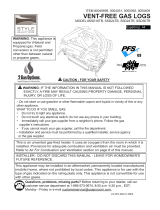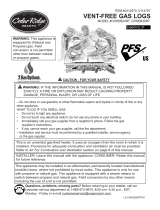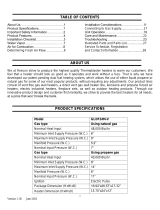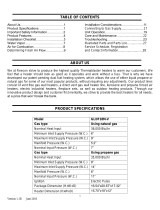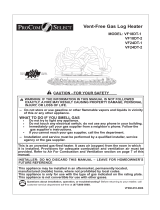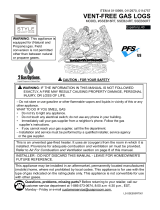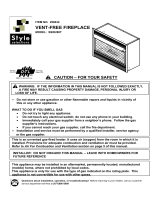Page is loading ...

For more information, visit www.desatech.com
WARNING: If the information in this manual is not
— WHAT TO DO IF YOU SMELL GAS
-
UNVENTED (VENT-FREE) GAS
LOG HEATER
OWNER’S OPERATION AND
INSTALLATION MANUAL
FLAME-MAX
®
VYM27NR AND VYM27PR
Remote Control Ready Models
Air for Combustion and
Ventilation

www.desatech.com
121353-01F2
SAFETY
alteration, service or
maintenance can cause
-
for correct installation
-
additional information
-
-
masonry or UL127 fac-
-
-
in accordance with ANSI
that includes instructions
-
-
stalled in an aftermarket,*
-
chemicals known to the State
of California to cause cancer or
-
-
TAbLE OF CONTENTS
Safety .................................................................. 2
Product Identication ........................................... 5
Local Codes......................................................... 5
Unpacking............................................................ 5
Product Features ................................................. 5
Remote Control Accessories ............................... 6
Air for Combustion and Ventilation ...................... 6
Installation ........................................................... 8
Operation ........................................................... 18
Inspecting Burners............................................. 22
Cleaning and Maintenance ................................ 23
Wiring Diagram .................................................. 24
Troubleshooting ................................................. 24
Specications .................................................... 28
Replacement Parts ............................................ 28
Service Hints ..................................................... 28
Technical Services ............................................. 28
Accessories ....................................................... 29
Parts .................................................................. 30
Warranty ..............................................Back Cover

www.desatech.com
121353-01F 3
Early signs
of carbon monoxide poisoning resemble the
u, with headaches, dizziness, or nausea.
If you have these signs, the heater may not
be working properly.
Have heater serviced. Some people are
more affected by carbon monoxide than oth-
ers. These include pregnant women, people
with heart or lung disease or anemia, those
under the inuence of alcohol, and those at
high altitudes.
Natural and
propane/LP gases are fuel gases. Fuel gases
are odorless. An odor-making agent are add-
ed to fuel gases. The odor helps you detect
a fuel gas leak. However, the odor added to
fuel gas can fade. Fuel gas may be present
even though no odor exists.
Make certain you read and understand all
warnings. Keep this manual for reference. It
is your guide to safe and proper operation of
this heater.
this heater or its controls can
WARNING: Do not use a
-
WARNING: Do not allow fans
will remain hot for a time after
-
dren when they are in the room
hand-held remote accessory,
-
-
1. This appliance is only for use with the type
of gas indicated on the rating plate. This
appliance is not convertible for use with
other gases.
2. Do not place propane/LP supply tank(s)
inside any structure. Locate propane/LP
supply tank(s) outdoors (propane/LP units
only).
3. To prevent performance problems, the
use of a propane/LP tank of less than
100 lbs. capacity is not recommended
(propane/LP units only).
SAFETY
Continued

www.desatech.com
121353-01F4
SAFETY
Continued
12. This heater needs fresh, outside air ven-
tilation to run properly. This heater has an
oxygen depletion sensing (ODS) pilot light
safety system. The ODS shuts down the
heater if not enough fresh air is available.
See Air for Combustion and Ventilation,
page 6. If heater keeps shutting off, see
Troubleshooting, page 24.
13. Do not run heater
• where ammable liquids or vapors are
used or stored
• under dusty conditions
14. Do not use this heater to cook food or burn
paper or other objects.
15. Do not use heater if any part has been ex-
posed to or under water. Immediately call
a qualied service technician to inspect
the room heater and to replace any part
of the control system and any gas control
which has been under water.
16. Do not operate heater if any log is broken.
Do not operate heater if a log is chipped
(dime-sized or larger).
17. Turn heater off and let cool before servic-
ing, installing, or repairing. Make sure the
selector switch is in the OFF position. Only
a qualied service person should install,
service, or repair heater.
18. Make sure the selector switch is in the
OFF position when you are away from
home for long periods of time.
19. This heater must not be connected to any
external electrical source.
20. Operating heater above elevations of
4,500 feet could cause pilot outage.
21. Provide adequate clearances around air
openings.
22. Keep burner and control compartment
clean.
23. Solid fuels shall not be burned in a re-
place in which an unvented room heater
is installed.
4. If you smell gas
• shut off gas supply
• do not try to light any appliance
• do not touch any electrical switch; do not
use any phone in your building
• immediately call your gas supplier from
a neighbor’s phone. Follow the gas
supplier’s instructions
• if you cannot reach your gas supplier,
call the re department
5. This heater shall not be installed in a
bedroom or bathroom unless installed as
a vented appliance (see Installing Damper
Clamp Accessory for Vented Operation,
page 11). This gas log set may not be
installed as a vented appliance in a bed-
room or bathroom in the Commonwealth
of Massachusetts.
6. Before installing in a solid fuel burning re-
place, the chimney ue and rebox must
be cleaned of soot, creosote, ashes and
loose paint by a qualied chimney cleaner.
Creosote will ignite if highly heated. A dirty
chimney ue may create and distribute
soot within the house. Inspect chimney
ue for damage. If damaged, repair ue
and rebox before operating heater.
7. Do not burn solid-fuel in a masonry or
UL127 factory-built replace in which a
vent-free room heater is installed.
8. If replace has glass doors, never operate
this heater with glass doors closed. If you
operate heater with doors closed, heat
buildup inside replace will cause glass to
burst. Make sure there are no obstructions
across openings of replace.
9. This log heater is designed to be smoke-
less. If logs ever appear to smoke, turn off
heater and call a qualied service person.
Note: During initial operation, slight smok-
ing could occur due to log curing and
heater burning manufacturing residues.
10. To prevent the creation of soot, follow the
instructions in Cleaning and Maintenance,
page 23.
11. Before using furniture polish, wax, carpet
cleaner, or similar products, turn heater
off. If heated, the vapors from these prod-
ucts may create a white powder residue
within burner box or on adjacent walls or
furniture.

www.desatech.com
121353-01F 5
Figure 1 - Product Identication
Control
Knob
Piezo
Ignitor
Log Set
Base
Assembly
Optional
Remote
Control
Flame
Adjustment
Knob
Optional
Selector
Switch
PRODUCT IDENTIFICATION
UNPACkING
CAUTION: Do not remove the
-
-
1. Remove logs and heater base assembly
from carton. Note: Do not pick up heater
base assembly by the burner. This could
damage heater. Always handle base as-
sembly by grate.
2. Remove all protective packaging applied
to logs and heater for shipment.
3. Check all items for any shipping damage.
If damaged, promptly inform dealer where
you bought heater.
PRODUCT FEATURES
OPERATION
This heater is clean burning. It requires no
outside venting. There is no heat loss out a
vent or up a chimney. Heat is generated by
realistic, dancing yellow ames. This heater
is designed for vent-free operation with ue
damper closed. It has been tested and
approved to ANSI Z21.11.2 standard for
unvented heaters. State and local codes in
some areas prohibit the use of vent-free heat-
ers. This heater may also be operated as a
vented decorative product (ANSI Z21.60) by
opening ue damper (non-thermostat opera-
tion only).
APPLICATION
These multisided logs are designed to be
equally beautiful when viewed from any angle.
They are designed specically for use in see-
through, peninsula, and island reboxes with
multiple openings. You may also install this
log heater in a standard rebox.
SAFETY PILOT
This heater has a pilot with an Oxygen Deple-
tion Sensing (ODS) safety shutoff system. The
ODS/pilot is a required feature for vent-free
room heaters. The ODS/pilot shuts off the
heater if there is not enough fresh air.
PIEZO IGNITION SYSTEM
This heater has a piezo ignitor. This system
requires no matches, batteries, or other
sources to light heater.
LOCAL CODES
Install and use heater with care. Follow all
local codes. In the absence of local codes,
use the latest edition of The National Fuel
Gas Code, ANSI Z223.1/NFPA 54*.
*Available from:
American National Standards Institute, Inc.
1430 Broadway
New York, NY 10018
National Fire Protection Association, Inc.
Batterymarch Park
Quincy, MA 02269
Note: Where listed vented decorative logs
are required, thermostat operation is not
permitted.
State of Massachusetts: The installation
must be made by a licensed plumber or
gas tter in the Commonwealth of Mas-
sachusetts.
Sellers of unvented propane or natural
gas-red supplemental room heaters shall
provide to each purchaser a copy of 527
CMR 30 upon sale of the unit.
Vent-free gas products are prohibited for
bedroom and bathroom installation in the
Commonwealth of Massachusetts.

www.desatech.com
121353-01F6
REMOTE CONTROL ACCESSORIES
you classify your space and provide adequate
ventilation.
The air that leaks around doors and windows
may provide enough fresh air for combus-
tion and ventilation. However, in buildings of
unusually tight construction, you must provide
additional fresh air.
as construction where:
-
-11
2
and
and
If your home meets all of the three criteria
See Ventilation Air From Outdoors
If your home does not meet all of the three
Determining Fresh-
Air Flow For Heater Location,
The National Fuel Gas Code, ANSI Z223.1/
NFPA 54 denes a conned space as a space
whose volume is less than 50 cubic feet per
1,000 Btu/hr (4.8 m
3
per kw) of the aggregate
input rating of all appliances installed in that
space and an unconned space as a space
whose volume is not less than 50 cubic feet per
1,000 Btu/hr (4.8 m
3
per kw) of the aggregate
input rating of all appliances installed in that
space. Rooms communicating directly with the
space in which the appliances are installed*,
through openings not furnished with doors, are
considered a part of the unconned space.
* Adjoining rooms are communicating only if
there are doorless passageways or ventilation
grills between them.
There are 4 optional controls that can be pur-
chased separately for this log heater:
• wall switch
• wall thermostat
• hand-held ON/OFF remote
• hand-held thermostat remote
See Accessories, page 29.
Note: The wall thermostat or hand-held
thermostat may not be used where vented
decorative listing is required.
AIR FOR COMbUSTION AND VENTILATION
WARNING: This heater shall
National Fuel Gas Code, ANSI
Z223.1/NFPA 54, the International
Fuel Gas Code,
Today’s homes are built more energy efcient
than ever. New materials, increased insula-
tion, and new construction methods help
reduce heat loss in homes. Home owners
weather strip and caulk around windows and
doors to keep the cold air out and the warm air
in. During heating months, home owners want
their homes as airtight as possible.
While it is good to make your home energy
efcient, your home needs to breathe. Fresh
air must enter your home. All fuel-burning ap-
pliances need fresh air for proper combustion
and ventilation.
Exhaust fans, replaces, clothes dryers, and
fuel burning appliances draw air from the house
to operate. You must provide adequate fresh
air for these appliances. This will insure proper
venting of vented fuel-burning appliances.
The following are excerpts from National Fuel
Gas Code, ANSI Z223.1/NFPA 54, Air for
Combustion and Ventilation.
All spaces in homes fall into one of the three
following ventilation classications:
1. Unusually Tight Construction
2. Unconned Space
3. Conned Space
The information on pages 6 through 8 will help

www.desatech.com
121353-01F 7
DETERMINING FRESH-AIR FLOW
FOR HEATER LOCATION
Use this work sheet to determine if you have
a conned or unconned space.
Includes the room in which you will
install heater plus any adjoining rooms with
doorless passageways or ventilation grills
between the rooms.
1. Determine the volume of the space (length
x width x height).
Length x Width x Height = __________ c u .
ft. (volume of space)
Example: Space size 20 ft. (length) x 16 ft.
(width) x 8 ft. (ceiling height) = 2560 cu. ft.
(volume of space)
If additional ventilation to adjoining room
is supplied with grills or openings, add the
volume of these rooms to the total volume
of the space.
2. Multiply the space volume by 20 to determine
the maximum Btu/Hr the space can support.
________ (volume of space) x 20 = (Maxi-
mum Btu/Hr the space can support)
Example: 2560 cu. ft. (volume of space) x 20
= 51,200 (maximum Btu/Hr the space can
support)
3. Add the Btu/Hr of all fuel burning appliances
in the space.
Vent-free heater _________Btu/Hr
Gas water heater* _________Btu/Hr
Gas furnace _________Btu/Hr
Vented gas heater _________Btu/Hr
Gas replace logs _________Btu/Hr
Other gas appliances* +_________Btu/Hr
Total =_________Btu/Hr
* Do not include direct-vent gas appliances.
Direct-vent draws combustion air from the
outdoors and vents to the outdoors.
Example:
Gas water heater* __________ Btu/Hr
Vent-free heater + _________ Btu/Hr
Total = _________ Btu/Hr
4. Compare the maximum Btu/Hr the space
can support with the actual amount of Btu/Hr
used.
______ Btu/Hr (maximum the space can
support)
______ Btu/Hr (actual amount of Btu/Hr
used)
40,000
33,000
73,000
Example: 51,200 Btu/Hr (maximum the
space can support)
73,000 Btu/Hr (actual amount of Btu/Hr
used)
The space in this example is a conned space
because the actual Btu/Hr used is more than the
maximum Btu/Hr the space can support. You
must provide additional fresh air. Your options
are as follows:
A. Rework worksheet, adding the space of an
adjoining room. If the extra space provides an
unconned space, remove door to adjoining
room or add ventilation grills between rooms.
See Ventilation Air From Inside Building.
B. Vent room directly to the outdoors. See
Ventilation Air From Outdoors, page 8.
C. Install a lower Btu/Hr heater, if lower Btu/Hr
size makes room unconned.
If the actual Btu/Hr used is less than the maxi-
mum Btu/Hr the space can support, the space is
an unconned space. You will need no additional
fresh air ventilation.
WARNING: If the area in which
-
National Fuel
Gas Code, ANSI Z223.1/NFPA 54,
the International Fuel Gas Code,
This fresh air would come from an adjoining
unconned space. When ventilating to an
adjoining unconned space, you must provide
two permanent openings: one within 12" of
the ceiling and one within 12" of the oor
on the wall connecting the two spaces (see
options 1 and 2, Figure 2, page 8). You can
also remove door into adjoining room (see
option 3, Figure 2). Follow the National Fuel
Gas Code, ANSI Z223.1/NFPA 54, Air for
Combustion and Ventilation for required size
of ventilation grills or ducts.
AIR FOR COMbUSTION AND VENTILATION
Continued

www.desatech.com
121353-01F8
INSTALLATION
Outlet
Air
V e ntilated
Attic
Outlet
Air
Inlet
Air
Inlet Air
V e ntilated
Crawl Space
T o
Crawl
Space
T o Attic
AIR FOR COMbUSTION AND VENTILATION
Continued
Figure 2 - Ventilation Air from Inside
Building
Or
Remove
Door into
Adjoining
Room,
Option
3
Ve ntilation Grills
Into Adjoining Room,
Option 2
Ve ntilation
Grills Into
Adjoining
Room,
Option 1
12"
12"
Provide extra fresh air by using ventilation
grills or ducts. You must provide two perma-
nent openings: one within 12" of the ceiling
and one within 12" of the oor. Connect these
Figure 3 - Ventilation Air from Outdoors
items directly to the outdoors or spaces open
to the outdoors. These spaces include attics
and crawl spaces. Follow the National Fuel
Gas Code, ANSI Z223.1/NFPA 54, Air for
Combustion and Ventilation for required size
of ventilation grills or ducts.
IMPORTANT: Do not provide openings for
inlet or outlet air into attic if attic has a thermo-
stat-controlled power vent. Heated air entering
the attic will activate the power vent.
NOTICE: This heater is intended
-
-
NOTICE: State or local codes may
-
-
-
WARNING: Seal any fresh
air vents or ash clean-out doors
-

www.desatech.com
121353-01F 9
WARNING: Never install the
heater
unless installed as a vented
-
are less than 42" from the front,
CAUTION: This heater cre-
currents move heat to wall sur-
heater next to vinyl or cloth wall
-
the air exist, may discolor walls
IMPORTANT: Vent-free heaters add moisture
to the air. Although this is benecial, installing
heater in rooms without enough ventilation
air may cause mildew to form from too much
moisture. See Air for Combustion and Ventila-
tion, page 6.
CHECK GAS TYPE
Use only the correct type of gas (natural or
propane/LP). If your gas supply is not the
correct gas type, do not install heater. Call
dealer where you bought heater for proper
type heater.
-
INSTALLATION
Continued
INSTALLATION AND CLEARANCES
WARNING: Maintain the
-
MINIMUM FIREPLACE CLEARANCE
Size
Width
27" 17" 19" 32"
Carefully follow the instructions below. This
will ensure safe installation into a masonry,
UL127-listed manufactured replace, or listed
vent-free rebox.
A. Clearances from the side of the replace
cabinet to any combustible material and
wall should follow diagram in Figure 4.
Example: The face of a mantel, bookshelf,
etc. is made of combustible material and
protrudes 3
1
/
2
" from the wall. This com-
bustible material must be 4" from the side
of the replace cabinet (see Figure 4).
Note: When installing your gas logs into
a manufactured rebox, follow rebox
manufacturer’s instructions for minimum
clearances to combustible materials.
B. Clearances from the top of the replace
opening to the ceiling should not be less
than 42".
Figure 4 - Minimum Clearance for
Combustible to Wall
*Minimum 16" from Side Wall
*
Example

www.desatech.com
121353-01F10
INSTALLATION
Continued
Figure 5 - Heat Resistant Material (Slate,
Marble, Tile, etc.) Above Fireplace
NOTICE: Manual control heaters
If so, you must always run heater
Installing Damper
Clamp Accessory for Vented
Operation
MATERIAL CLEARANCES
Note: If using a mantel, proceed to If Using
Mantel. If not using a mantel, follow the infor-
mation below.
You must have noncombustible material(s)
above both replace openings. Noncombus-
tible materials (such as slate, marble, tile, etc.)
must be at least 1/2" thick. With sheet metal,
you must have noncombustible material be-
hind it. Noncombustible material must extend
at least 8" up. If noncombustible material is
less than 12", you must install the replace
hood accessory. See Figure 5 for minimum
clearances.
IMPORTANT: If you cannot meet these mini-
mum clearances, you must operate heater
with chimney ue damper open. Go to Install-
ing Damper Clamp Accessory for Vented
Operation, page 12.
You must have noncombustible material(s)
above the replace opening. Noncombustible
materials (such as slate, marble, tile, etc.)
must be at least 1/2" thick. With sheet metal,
you must have noncombustible material be-
hind it. Noncombustible material must extend
Safe Installation
12" or more Noncombustible
material OK.
Between 8" and 12" Install replace hood
accessory (GA6050,
GA6052, or GA6053
see Accessories,
page 29).
Less than 8" Noncombustible
material must be
extended to at least
8". See Between 8"
and 12", above. If
you cannot extend
material, you must
operate heater with
ue damper open.
at least 8" up. If noncombustible material is
less than 12", you must install the replace
hood accessory. Even if noncombustible
material is more than 12", you may need the
hood accessory to deect heat away from
your mantel shelf. See Figure 5 and Figures 6
and 7, page 11, for minimum clearances.

www.desatech.com
121353-01F 11
Figure 6 - Minimum Mantel Clearances Without Using Hood
Minimum
Noncombustible
Material
Minimum
Noncombustible
Material Height
Distances to
Underside of
Mantel
Top of
Fireplace
Opening
Underside
of Mantel
Shelf
Mantel Shelf
12"
(A)
18" 20" 22" 24"
All
minimum
distances
are in
inches
2
1
/
2
"
6"
8"
10"
Figure 7 - Minimum Mantel Clearances When Using Hood
Minimum
Noncombustible
Material
8"
Min.
12" 15" 18" 20"
2½"
6"
8"
10"
12"
Distances to
Underside of
Mantel
Hood
(GA6050,
GA6052 or
GA6053)
Top of
Fireplace
Opening
Underside
of Mantel
Shelf
Mantel Shelf
INSTALLATION
Continued

www.desatech.com
121353-01F12
14"
Min.
Combustible
Material
Noncombustible Material
MANTEL CLEARANCES
In addition to meeting noncombustible mate-
rial clearances, you must also meet required
clearances between replace openings and
mantel shelf on each side of the replace. If
you do not meet the clearances listed below,
you will need a hood.
If you meet minimum clearance between man-
tel shelf and top of replace opening, a hood
is not required (see Figure 6, page 11).
If minimum clearances in Figure 6 are not
met, you must have a hood. When using a
hood there are still certain minimum mantel
clearances required. Follow minimum clear-
ances shown in Figure 7, page 11, when
using hood.
-
-
Follow all minimum clearances
NOTICE: If your installation does
not meet the minimum clear-
ances shown, you must do one
-
FLOOR CLEARANCES
A. If installing appliance on the oor level,
you must maintain the minimum distance
of 14" to combustibles (see Figure 8).
B. If combustible materials are less than 14"
to the replace, you must install appliance
at least 5" above the combustible ooring
(see Figure 9).
Figure 8 - Minimum Fireplace Clearances
If Installed at Floor Level
INSTALLING DAMPER CLAMP
OPERATION
Note: When used as a vented heater, ap-
pliance must be installed only in a solid-fuel
burning replace with a working ue and con-
structed of noncombustible material.
For Massachusetts Residents Only: Instal-
lation of this vented gas log set in the Com-
monwealth of Massachusetts requires the
damper be permanently removed or welded
in the fully open position.
If your heater is a manually controlled model,
you may use this heater as a vented product.
There are three reasons for operating your
heater in the vented mode:
1. The replace does not meet the clearance
to combustibles requirements for vent-
free operation
2. State or local codes do not permit vent-
free operation
3. You prefer vented operation
If reasons number 1 or 2 above apply to you,
you must permanently open chimney ue
damper. You must install the damper clamp
accessory (to order, see Accessories, page
29). This will insure vented operation (see
Figure 10, page 13). The damper clamp will
keep damper open. Installation instructions
are included with clamp accessory.
Hearth
5"
Min.
Combustible
Material
Figure 9 - Minimum Fireplace Clearances
Above Combustible Flooring
INSTALLATION
Continued

www.desatech.com
121353-01F 13
INSTALLATION
Continued
Diameter Area
5" 20 sq. inches
6" 29 sq. inches
7" 39 sq. inches
8" 51 sq. inches
Minimum Permanent
6' to 15' 39 sq. inches
15' to 30' 29 sq. inches
Damper Clamp
Damper
Clamp
Damper
Damper
Manufactured
Figure 10 - Attaching Damper Clamp
CAUTION: Do not remove the
WARNING: You must secure
not, heater will move when you
-
-
-
IMPORTANT: Make sure the heater burner
is level. If heater is not level, heater will not
work properly.
Installation Items Needed
• hardware package (provided with heater)
• approved flexible gas hose (provided)
(if allowed by local codes)
• sealant (resistant to propane/LP gas, not
provided)
• electric drill with 3/16" drill bit (metal or
masonry as applicable)
• athead screwdriver
1. Apply pipe joint sealant lightly to male
threads of the tting to be threaded into
gas control. Connect approved exible gas
hose (provided for VYM models only) to
gas control tting in heater (see Figure 11).
IMPORTANT: Hold gas tting with wrench
when connecting exible gas hose.
2. Locate 2 masonry screws in hardware
package.
See chart below for minimum permanent ue
opening you must provide. Attach damper
clamp so the minimum permanent ue open-
ing will be maintained at all times.
Fitting
Flexible Gas Hose
(Provided for VYM
models only) (if
allowed by local codes)
Figure 11 - Attaching Flexible Gas Hose
to Heater

www.desatech.com
121353-01F14
INSTALLATION
Continued
3. Place heater base in replace.
4. Place logs in their proper position on heater
base. See Installing Logs, page 17.
5. Center heater base and logs front-to-back
and side-to-side in replace.
6. Carefully remove logs without moving
heater base.
7. Mark screw locations through one hole on
each side of the mounting bracket (see
Figure 12). If installing in a brick-bottom
replace, mark screw locations in mortar
joint of bricks.
8. Remove heater base from replace. If
installing optional control accessories,
do so at this time. Follow all directions
provided with accessory.
9. Drill holes at marked locations using 3/16"
drill bit.
10. Attach base assembly to replace oor
using two masonry screws (in hardware
package).
Figure 12 - Attaching Base Assembly to
Fireplace Floor
Masonry
Screw
Mounting
Flanges
CONNECTING TO GAS SUPPLY
-
WARNING: Never connect
-
Figure 13 - External Regulator With Vent
Pointing Down (Propane/LP gas only)
Propane/LP
Supply Tank
External
Regulator
with Vent
Pointing
Down
WARNING: Never connect
Installation Items Needed
Before installing heater, make sure you have
the items listed below.
• external regulator (for propane/LP units
only, supplied by installer)
• piping (check local codes)
• sealant (resistant to propane/LP gas)
• equipment shutoff valve *
• test gauge connection *
• sediment trap
• tee joint
• pipe wrench
* A CSA design-certied equipment shutoff
valve with 1/8" NPT tap is an acceptable al-
ternative to test gauge connection. Purchase
the optional CSA design-certied equipment
shutoff valve from your dealer. See Acces-
sories, page 29.
For propane/LP units, the installer must
supply an external regulator. The external
regulator will reduce incoming gas pressure.
You must reduce incoming gas pressure to
between 11" and 14" of water. If you do not re-
duce incoming gas pressure, heater regulator
damage could occur. Install external regulator
with the vent pointing down as shown in Figure
13. Pointing the vent down protects it from
freezing rain or sleet.

www.desatech.com
121353-01F 15
CAUTION: Use only new,
-
Installation must include an equipment shutoff
valve, union, and plugged 1/8" NPT tap. Lo-
cate NPT tap within reach for test gauge hook
up. NPT tap must be upstream from heater
(see Figure 14).
IMPORTANT: Install equipment shutoff valve
in an accessible location. The equipment
shutoff valve is for turning on or shutting off
the gas to the appliance.
Check your building codes for any special
requirements for locating equipment shutoff
valve to replaces.
Apply pipe joint sealant lightly to male NPT
threads. This will prevent excess sealant from
going into pipe. Excess sealant in pipe could
result in clogged heater valves.
INSTALLATION
Continued
* Purchase the optional CSA design-certied
equipment shutoff valve from your dealer. See
Accessories, page 29.
** Minimum inlet pressure for purpose of input
adjustment.
Figure 14 - Gas Connection
Gas Control
3" Minimum
CSA Design-
Certied
Equipment
Shutoff Valve
With 1/8" NPT
Tap*
Approved Flexible Gas Hose
(if allowed by local codes)
Pipe Tee
Nipple Cap Joint
Sediment Trap
Natural Gas
From Gas Meter (5" W.C.**
to 10.5" W.C. Pressure)
From External Regulator
(11" W.C.** to 14" W.C.
Pressure)
We recommend that you install sediment trap
in supply line as shown in Figure 14. Locate
sediment trap where it is within reach for
cleaning. Install in piping system between
fuel supply and heater. Locate sediment
trap where trapped matter is not likely to
freeze. A sediment trap traps moisture and
contaminants. This keeps them from going
into heater controls. If sediment trap is not
installed or is installed wrong, heater may
not run properly.
CHECKING GAS CONNECTIONS
and connections, internal and
external to unit, for leaks after
WARNING: Never use an
-
-
Connect-
ing to Gas Supply

www.desatech.com
121353-01F16
INSTALLATION
Continued
PRESSURE TESTING HEATER GAS
CONNECTIONS
1. Open equipment shutoff valve (see Fig-
ure 15).
2. Open main gas valve located on or near
gas meter for natural gas or open pro-
pane/LP supply tank valve.
3. Make sure control knob of heater is in the
OFF position.
4. Check all joints from equipment shutoff
valve to control valve (see Figure 16 or
17). Apply a noncorrosive leak detection
uid to gas joints. Bubbles forming show
a leak.
5. Correct all leaks at once.
6. Light heater (see Operation, page 18).
Check all other internal joints for leaks.
7. Turn off heater (see To Turn Off Gas to
Appliance, page 20).
Figure 17 - Checking Gas Joints for
Propane/LP Gas
Control Valve
Location
Propane/LP
Supply Tank
Equipment Shutoff Valve
Figure 16 - Checking Gas Joints for
Natural Gas
Gas Meter
Equipment Shutoff Valve
Control Valve
Location
Figure 15 - Equipment Shutoff Valve
Open
Closed
Equipment
Shutoff
Valve
PRESSURE TESTING GAS SUPPLY
PIPING SYSTEM
Test Pressures In Excess Of 1/2 PSIG
1. Disconnect appliance with its appliance
main gas valve (control valve) and equip-
ment shutoff valve from gas supply piping
system. Pressures in excess of 1/2 psig
will damage heater regulator.
2. Cap off open end of gas pipe where equip-
ment shutoff valve was connected.
3. Pressurize supply piping system by either
opening propane/LP supply tank valve
for propane/LP gas, or opening main gas
valve located on or near gas meter for
natural gas, or using compressed air.
4. Check all joints of gas supply piping sys-
tem. Apply a noncorrosive leak detection
uid to gas joints. Bubbles forming show
a leak.
5. Correct all leaks at once.
6. Reconnect heater and equipment shutoff
valve to gas supply. Check reconnected
ttings for leaks.
1. Close equipment shutoff valve (see Fig-
ure 15).
2. Pressurize supply piping system by either
opening propane/LP supply tank valve
for propane/LP gas, or opening main gas
valve located on or near gas meter for
natural gas, or using compressed air.
3. Check all joints from gas meter to equip-
ment shutoff valve for natural gas or
propane/LP supply to equipment shutoff
valve for propane/LP (see Figure 16 or
17). Apply a noncorrosive leak detection
uid to gas joints. Bubbles forming show
a leak.
4. Correct all leaks at once.

www.desatech.com
121353-01F 17
INSTALLATION
Continued
3. Position log piece (#3) by aligning holes
on underside with remaining pegs on bot-
tom log as illustrated in Figure 21. Do not
4. Place lava rock around base of heater if
desired.
INSTALLING LOGS
CAUTION: After installa-
-
It is very important to install the logs exactly
as instructed. Do not modify logs. Only use
logs supplied with heater.
1. Place bottom log (#1) on grate to t as
illustrated in Figure 18. Make sure open
areas of logs line up with burner ports
(see Figure 19). Logs will t securely on
chassis. IMPORTANT: Make sure log
does not cover any burner ports.
2. Facing front of unit, place top log (#2)
omto the pegs in the center of the bottom
log as illustrated in Figure 20.
Figure 18 - Installing Bottom Log (#1)
Figure 19 - Installing Log set (Top View)
Logs
Burner Ports
Figure 20 - Installing Top Log(#2)
Bottom Log (#1)
Burner
Chassis
Grate
Burner Port
Top Log
(#2)
Peg
Figure 21 - Installing Log Piece (#3)
Log Piece (#3)
Peg

www.desatech.com
121353-01F18
OPERATION
LIGHTING
INSTRUCTIONS
WARNING:
-
erate heater with doors closed,
Note: Homeowners generally prefer to oper-
ate their heater with the chimney damper
closed. This will put all the heat into the room.
However, there may be times you will desire
the full ames of the HI heat setting but will
nd the heat output excessive. You can open
the chimney damper (if you have one) fully or
partially to release some of the heat.
1. STOP! Read the safety information, col-
umn 1.
2. Make sure equipment shutoff valve is
fully open.
3. Set switch in the OFF position.
on automatically within one
minute when the selector switch
4. Press in and turn control knob clockwise
to the OFF position.
FOR YOUR SAFETY
WARNING: If you do not fol-
low these instructions exactly,
-
WHAT TO DO IF YOU SMELL GAS
-

www.desatech.com
121353-01F 19
OPERATION
Continued
5. Wait ve (5) minutes to clear out any gas.
Then smell for gas, including near the
oor. If you smell gas, STOP! Follow “B”
in the safety information, page 18. If you
don’t smell gas, go to the next step.
6. Press in and turn control knob counter-
clockwise to the PILOT position.
Press in control knob for ve (5) seconds
(see Figure 22).
Note: You may be running this heater
for the rst time after hooking up to gas
supply. If so, the control knob may need
to be pressed in for 30 seconds or more.
This will allow air to bleed from the gas
system.
7. With control knob pressed in, press and
release ignitor button. This will light pilot.
The pilot is attached to the front burner. If
needed, keep pressing ignitor button until
pilot lights.
Note: If pilot does not stay lit, contact a
qualied service person or gas supplier
for repairs. Until repairs are made, light
pilot with match. To light pilot with match,
see Manual Lighting Procedure.
8. Keep control knob pressed in for 30 sec-
onds after lighting pilot. After 30 seconds,
release control knob.
• If control knob does not pop out when
released, contact a qualified service
person or gas supplier for repairs.
Note: If pilot goes out, repeat steps 4
through 8.
9. Slightly push in and turn control knob coun-
terclockwise to the ON position.
Flame Adjustment Knob
Figure 22 - Control Knob and Ignitor
Button Location (Shown as Supplied, No
Control Options)
O
F
F
P
I
L
O
T
L
O
I
H
AUTO
OFF
ON
O
N
Control Knob
Ignitor Button
Selector
Switch
10. Wait one minute and switch selector
switch to the ON position to light burner.
Note: AUTO is only functional when using
GWMT1, or GWMS2 optional accesso-
ries.
11. Set ame adjustment knob to any level
between HI and LO.
12. To shut off burner and keep pilot lit do
one of the following: Turn control knob
clockwise to the PILOT position,
use remote control manual OFF button or
set selector switch in the OFF position.
CAUTION: Do not try to ad-
WARNING: Make sure the
selector switch is in the OFF
Heater will come on automati-
cally with selector switch in the
Pilot Burner
Figure 24 - Propane/LP Gas Pilot
Figure 23 - Natural Gas Pilot
Ignitor
Electrode
Pilot Burner
Ignitor
Electrode

www.desatech.com
121353-01F20
TO TURN OFF GAS
TO APPLIANCE
1. Turn control knob clockwise to the
OFF position.
2a. Set selector switch in the OFF position.
2b.
Set selector switch in the OFF position to
prevent draining battery.
3. Close equipment shutoff valve (see Figure
15, page 16).
MANUAL LIGHTING
PROCEDURE
1. Follow steps 1 through 6 under Lighting
Instructions, page 18.
2. Press control knob and light pilot with
match.
3. Keep control knob pressed in for 30 sec-
onds after lighting pilot. After 30 seconds,
release control knob. Now follow steps 9
through 11 under Lighting Instructions,
page 19.
OPTIONAL HAND-HELD
REMOTE OPERATION
All remote control accessories must be pur-
chased separately (see Accessories, page
29). Follow instructions included with the
remote control.
-
Lighting
Instructions
After lighting, let pilot ame burn for about
one minute. Turn control knob to ON position.
Adjust ame adjustment knob anywhere be-
tween HI and LO. Slide the selector switch to
the REMOTE position (see Figure 25).
Note: The burner may light if hand-held re-
mote was on when selector switch was last
turned off. You can now turn the burner on and
off with the hand-held remote control unit.
IMPORTANT: Do not leave the selector switch
in the REMOTE or ON position when the pilot
is not lit. This will drain the battery.
OPERATION
Continued
Figure 25 - Setting the Selector Switch,
Control Knob, and Flame Adjustment
Knob for Hand-Held Remote Operation
Selector Switch in Remote Position
(Optional Hand-Held Remote Control)
ON
OFF
REMOTE
O
F
F
P
I
L
O
T
L
O
I
H
O
N
Control Knob
in On Position
Flame
Adjustment Knob
Hold the control button on the hand-held
remote until burner turns on. Hold the con-
trol button again until burner turns off (see
Figure 26).
To Lock press both buttons on hand-held
remote control until light stops ashing. Hand-
held remote control is now locked. If the re
is on it will be turned off automatically. In the
locked state, the light will not light up when
any button is pressed.
To Unlock press both buttons together
on hand-held remote control until the light
stops ashing. The hand-held remote is now
unlocked.
Figure 26 - On/Off Hand-Held Remote
Control Unit
Control
Button
Indicator
Light
Piezo
Ignitor
/
